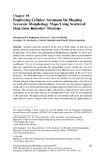| dc.contributor.author | Kapoutsis, Athanasios Ch. | |
| dc.contributor.author | Chatzichristofis, Savvas A. | |
| dc.contributor.author | Sirakoulis, Georgios Ch. | |
| dc.contributor.author | Doitsidis, Lefteris | |
| dc.contributor.author | Kosmatopoulos, Elias B. | |
| dc.date.accessioned | 2017-11-01T08:09:11Z | |
| dc.date.available | 2017-11-01T08:09:11Z | |
| dc.date.issued | 2015 | |
| dc.identifier.uri | http://hdl.handle.net/11728/10177 | |
| dc.description.abstract | Accurate maps are essential in the case of robot teams, so that they can operate autonomously and accomplish their tasks efficiently. In this work we present an approach which allows the generation of detailed maps, suitable for robot navigation, from a mesh of sparse points using Cellular Automata and simple evolutions rules. The entire map area can be considered as a 2D Cellular Automaton (CA) where the value at each CA cell represents the height of the ground in the corresponding coordinates. The set of measurements form the original state of the CA. The CA rules are responsible for generating the intermediate heights among the real measurements. The proposed method can automatically adjust its rules, so as to encapture local morphological attributes, using a pre-processing procedure in the set of measurements. The main advantage of the proposed approach is the ability to maintain an accurately reconstruction even in cases where the number of measurements are significant reduced. Experiments have been conducted employing data collected from two totally different real-word environments. In the first case the proposed approach is applied, so as to build a detailed map of a large unknown underwater area in Oporto, Portugal. The second case concerns data collected by a team of aerial robots in real experiments in an area near Zurich, Switzerland and is also used for the evaluation of the approach. The data collected, in the two aforementioned cases, are extracted using different kind of sensors and robots, thus demonstrating the applicability of our approach in different kind of devices. The proposed method outperforms the performance of other well-known methods in literature thus enabling its application for real robot navigation.
The research leading to these results has received funding from the European Communities Seventh Framework Programme (FP7/2007–2013) under grant agreements n. 270180 (NOPTILUS) | en_UK |
| dc.language.iso | en | en_UK |
| dc.publisher | Springer | en_UK |
| dc.relation.ispartofseries | Robots and Lattice Automata;p.p 229-246 | |
| dc.rights.uri | http://creativecommons.org/licenses/by-nc-nd/4.0/ | en_UK |
| dc.subject | Cellular Automaton (CA) | en_UK |
| dc.subject | robotic | en_UK |
| dc.title | Employing Cellular Automata for Shaping Accurate Morphology Maps Using Scattered Data from Robotics’ Missions | en_UK |
| dc.type | Book chapter | en_UK |
| dc.doi | 10.1007/978-3-319-10924-4_10 | en_UK |


